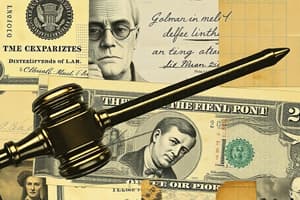Podcast
Questions and Answers
What is the main difference between forgery and counterfeiting?
What is the main difference between forgery and counterfeiting?
- Forgery involves altering genuine documents, while counterfeiting involves creating fake items. (correct)
- Forgery is limited to financial instruments, while counterfeiting is limited to historical artifacts.
- Forgery involves creating fake items, while counterfeiting involves altering genuine documents.
- Forgery is legal, while counterfeiting is illegal.
Which of the following actions exemplifies forgery?
Which of the following actions exemplifies forgery?
- Altering a historical artifact for personal use.
- Forging someone's signature on a check. (correct)
- Producing counterfeit coins to deceive collectors.
- Creating a fake painting and selling it as an original masterpiece.
What is the key aspect of physical forgery?
What is the key aspect of physical forgery?
- Creating or altering tangible items like signatures physically. (correct)
- Altering intangible items virtually.
- Copying electronic files without permission.
- Creating fake documents online.
In the context of counterfeiting, what does 'producing fake or imitation items' refer to?
In the context of counterfeiting, what does 'producing fake or imitation items' refer to?
Which action would be considered counterfeiting based on the information provided?
Which action would be considered counterfeiting based on the information provided?
What is the primary aim behind forgery?
What is the primary aim behind forgery?
What is physical forgery?
What is physical forgery?
What is moral forgery?
What is moral forgery?
According to the Egyptian law, what constitutes forgery?
According to the Egyptian law, what constitutes forgery?
What are governmental documents?
What are governmental documents?
What is the goal of securing governmental documents?
What is the goal of securing governmental documents?
Which of the following is an example of a non-governmental document?
Which of the following is an example of a non-governmental document?
Flashcards are hidden until you start studying
Study Notes
Forgery and Counterfeiting
- Forgery and counterfeiting are forms of deception or fraud involving the creation of false documents or items with the intent to deceive others.
- They share similarities, but differ in their specific characteristics.
Definition of Forgery
- Unauthorized creation or alteration of legal documents, financial instruments, art, or historical artifacts with the intent to deceive or defraud others.
- Examples: forging someone's signature on a check or altering a legal document to change its terms.
Definition of Counterfeiting
- Production of fake or imitation items, particularly metal currency.
- Example: making a counterfeit of a currency (protected coin) with the intent to pass or tender it as genuine.
Types of Forgery
Physical Forgery
- Creation or alteration of physical documents, signatures, artwork, or other tangible items with the intent to deceive or defraud.
- Involves directly manipulating physical objects to create false representations of genuine items.
- Examples: forging signatures on checks, altering legal documents.
Moral Forgery
- Change in the truth in the content and meaning of the document while issuing it.
- No physical appearance in moral forgery left in the document, because it was done during the creation of the document.
- Example: issuing genuine identification document as Passport by using fake document as identification document (ID).
Governmental and Non-Governmental Documents
Governmental Documents
- Official records, papers, or documents produced, issued, or maintained by a government entity or agency.
- Examples: governmental identification documents (i.e., passports, national identity cards, driver's licenses), birth certificates, death certificates, graduation certificates, government reports, court judgments, and official agencies.
Non-Governmental Documents
- Records, papers, or materials created, issued, or maintained by entities other than government agencies.
- Examples: business contracts, reports, personal correspondence, organizational records, and any written piece of paper.
Securing Governmental Documents
- Implementing measures and protocols to safeguard official documents, records, papers, or materials produced, issued, or maintained by government entities or agencies.
- Goal: to protect sensitive information, ensure the integrity of official documents, and prevent unauthorized access.
Studying That Suits You
Use AI to generate personalized quizzes and flashcards to suit your learning preferences.




